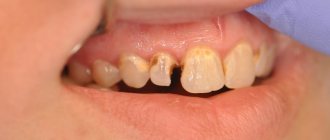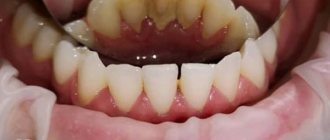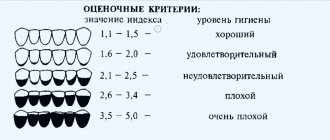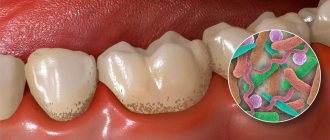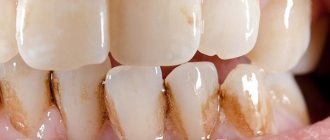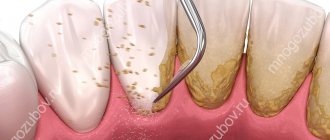Why do you need teeth polishing?
Despite the fact that grinding and polishing are included in the complex of measures for removing stone, they can also be used as independent procedures aimed at improving the general condition of the enamel.
- Grinding is performed in order to remove unevenness and microcracks from the enamel surface. Thus, grinding the enamel helps reduce plaque and slows down the formation of stones. In addition, grinding helps improve the general condition of the enamel and is one of the preventive measures for the development of caries.
- Polishing is carried out after grinding. It is intended for the final leveling of micro-irregularities on the enamel that could remain after grinding. In general, polishing is more cosmetic in nature and provides a slight whitening effect.
Medical Internet conferences
Introduction. Professional hygiene has always been the subject of attention of dentists, since the result depends entirely on the choice of the optimal cleaning system and cleaning products. According to statistics, about 80% of people have soft and hard dental plaque, which if not treated in a timely manner can lead to aggravating consequences - the spread of the infectious process, the formation of caries, periodontitis, and gingivitis. An important aspect of this problem is the individualization of the choice of polishing pastes during professional cleaning in accordance with different clinical situations among the great variety of polishing pastes.
Purpose: to compare the effectiveness of polishing pastes based on perlite and silicon oxide, study their properties, and optimize the selection depending on the clinical case.
Tasks:
- To identify the relevance of professional teeth cleaning as a means of preventing dental diseases.
- Study of polishing pastes based on perlite and silicon oxide.
- Comparative analysis of selected pastes.
Materials and methods. An analysis of scientific articles, scientific literature, dental journals, as well as various websites and brochures was carried out.
Results and discussion. Professional oral hygiene is an integral part of the prevention of dental diseases. The main problem among many preventive measures is the control of dental plaque, which will subsequently lead to complications such as dental caries and inflammatory periodontal diseases.
We should not lose sight of individual oral hygiene as a method of preventing and preventing complications; however, self-cleaning is not enough to completely remove dental plaque, which is what professional oral hygiene will help us with. To maintain health, comprehensive measures to prevent the development of caries and other oral diseases should be carried out regularly every six months.
Professional hygiene is a set of measures that eliminate and prevent the causes of dental caries and inflammatory diseases of periodontal tissues through mechanical removal of dental plaque. Polishing pastes are used as professional hygiene products, which have a number of characteristics used depending on a particular clinical situation.
The dentist’s tasks, first of all, include choosing the most optimal paste, with requirements corresponding to the individual needs of the doctor for the most productive and effective professional teeth cleaning.
There are a great variety of polishing pastes, and without a conscious choice and knowledge, making the right choice is not so easy even for a professional, because every year more and more innovative materials, once previously unknown, appear on the dental market. And here the dentist must choose the most optimal, effective material that meets all the requirements, with which he will work with ease and convenience.
Polishing pastes are different in their composition and characteristics: fluorine content, antiseptic agents, grain size (coarse, fine, medium-fine), abrasive fillers (pumice, perlite, aluminum silicate, aluminum oxide, silicon dioxide, zircon), they also have pleasant taste (mint, cherry).
Let's look at the most famous polishing pastes.
Perlite based pastes.
— abrasive paste for professional cleaning and polishing of teeth, during a comprehensive procedure for professional oral hygiene, is also used to remove discoloration from food dyes of varying degrees of intensity, together with a powder system of the same line.
The paste has an anti-carious effect and contains fluoride ions, which seals the dentinal tubules, has a remineralizing effect and reduces hypersensitivity. The paste has adaptive abrasiveness - during its use, the abrasive particles are crushed, thereby reducing the impact on the enamel. The paste has a low abrasive effect on enamel and dentin - gently removing plaque due to different degrees of grain size: fine, medium, coarse, which is convenient for selection in accordance with the individual clinical situation and the level of intensity of discoloration. The abrasive components in the pastes eliminate discoloration, removing pigmented plaque on the teeth, thereby providing a brightening effect.
Thus: fine-grained paste is intended for easy polishing and cleaning; medium-grain paste is intended for general polishing and cleaning; coarse paste – designed to remove medium-intensity discoloration and plaque.
Perlite-based pastes are available in convenient portion packaging - 2 g capsules, in addition, the paste is color-coded according to abrasiveness, which is very convenient to use: gold - fine grain, turquoise - medium grain, red - coarse grain. The consistency is presented in such a way that minimal splashing is ensured during manipulation. The paste has good abrasiveness, represented by natural porous volcanic rock - perlite.
Perlite turns from coarse to fine-grained under load. Perlite particles are transformed from coarse crystals into fine particles that can provide a gentle and effective polishing of teeth. Perlite has a rich mineral composition: Table No. 1.
Pastes based on silicon oxide.
Abrasive paste for professional teeth cleaning and polishing.
Widely used - used for:
- removal of dental plaque (superficial, soft, hard);
- removing dental discoloration from food dyes of varying degrees of intensity (plaque from coffee, tea, tobacco);
- cleaning and polishing fillings;
- removing remnants of temporary fixing material.
Available in the form of a 100g tube, with a refreshing menthol taste. The paste has a homogeneous consistency, has an anti-caries effect, contains fluoride ions, resulting in remineralization, as well as a reduction in tooth sensitization.
According to the standard, it has three degrees of abrasiveness, which will allow the doctor to individually select the degree of grit of the paste, depending on the intensity and amount of dental plaque in the patient and the general condition of the teeth.
There is a color coding according to the degree of abrasiveness: red – high cleaning intensity, yellow – medium cleaning intensity, green – gentle polishing paste, also suitable for caring for implants.
The consistency is presented in such a way that minimal splashing is ensured during manipulation. The paste contains xylitol, a sugary alcohol of natural origin, which prevents caries by suppressing cariogenic microflora and maintaining the natural acid-base balance of the oral cavity.
The paste is contraindicated for persons with hypersensitivity to menthol, since this component is included in the paste.
Comparative characteristics of polishing pastes are presented in Table No. 2.
Conclusions:
- Professional teeth cleaning using special toothpastes is a necessary condition for the effective prevention of caries and its complications.
- The composition of the pastes significantly influences the result of prevention and optimizes the process of mechanical cleaning of teeth.
- Based on research data, silicon oxide-based paste can be considered more effective.
Polishing teeth with paste
Teeth polishing is part of a set of procedures for cleaning teeth from plaque and stones. After removing stones using ultrasound or laser, the surface of the teeth becomes somewhat rough. This is not visually visible, but the patient feels this discomfort and the surrounding mucous membranes are constantly irritated. Roughness contributes to the rapid accumulation of plaque and bacteria, which exacerbate inflammatory processes in the oral cavity.
It is for the purpose of removing these roughnesses that grinding and polishing of teeth is carried out. On the smooth surface of teeth, plaque does not linger for long and bacteria have nothing to cling to. This means that the growth of a new layer of plaque, and especially the formation of tartar, will not bother you for a long time.
Teeth grinding tools
For polishing, special tools with rotating heads are used, which are fixed to the contra-angle tip of the drill. The principle of operation is the complex use of cleaning mechanisms and abrasive pastes.
The following are used as nozzles:
- rubber cups – suitable for treating flat tooth surfaces;
- cone-shaped brushes – designed for lumpy areas;
- polishing strips (strips) coated with aluminum oxide or diamond coating - for cleaning proximal surfaces, that is, the area of contact between the teeth.
During the polishing process, the dentist alternately uses several types of abrasive pastes, ranging from coarse to medium- or fine-grained.
The degree of abrasiveness of the paste is indicated by the RDA index:
- 250 (blue) – coarse-grained mixture for removing dense deposits;
- 170 (green) – medium-grained;
- 120 (red) – fine paste;
- 40 (yellow) – extra soft for final polishing.
The main component (abrasive) of polishing pastes is silica, ground zircon, silicate or zirconium oxide. The preventive effect is provided by such useful components as ionized fluorine and xylitol.
Abrasive tooth polishing paste
Recommendations after the teeth polishing procedure
To maximize the effect of the procedure, it is important to follow the dentist’s recommendations and follow simple rules:
- for the first 2-3 days, avoid eating foods containing dyes: tea, coffee, wine, juices, etc.,
- food should not be too hot or cold, because the sensitivity of the enamel increases in the first days after polishing,
- When brushing your teeth, you should not use whitening pastes, as they can damage the enamel,
- In the first days after polishing, you should stop smoking, because the acids contained in tobacco smoke corrode the protective layer of enamel, and this accelerates the formation of plaque.
If you follow the recommendations and take good care of your teeth, professional cleaning will not be needed soon, and your teeth will remain healthy.
Contraindications
As mentioned earlier, polishing is a necessary step in many dental procedures. But there are situations when you have to refuse to implement it. The most common cause is bleeding gums. This can occur both due to the presence of an advanced stage of the disease, and due to the characteristics of the tissues, when they are very delicate and react to the slightest mechanical contact.
Also, a temporary limitation will be the diagnosis of periodontal disease or periodontitis in the acute stage, pulpitis, cysts or granulomas in the patient. The planned procedure will also have to be postponed for a short time if there are multiple carious cavities in the oral cavity. Only after completion of treatment can you begin grinding.
Most methods are not suitable for those who have very thin and sensitive enamel. Even if polishing is successful, a person may later experience unpleasant symptoms: pain, reaction to cold, etc. If the patient has a tendency to allergic reactions, the medications used by the doctor may not be suitable for him. Other contraindications include oncology, diabetes, epilepsy, kidney and heart diseases.
Reviews about our dental therapists
I would like to express my gratitude to the dentist Elena Nikolaevna Kiseleva and her assistant Svetlana - they are real specialists and at the same time sensitive, not burnt out by years of practice.
Thanks to them, I have been coming back here for many years. Thanks to the management for such doctors! Read full review Svetlana Nikolaevna
13.08.2021
Words cannot express my gratitude to Elena Nikolaevna Kiseleva. This is the best doctor in the world. I got an appointment after many years of being ignored by the dentist’s office and with a bitter experience of treatment in another paid clinic, the mistakes of which had to be corrected in the first visits. Thank you for this... Read full review
Roman Stanislavovich Sh
25.07.2020
Restoration methods
Recovery is accomplished in many different ways. The main classification is direct or indirect method.
Straight
The direct method is popularly called filling. Includes the following varieties:
- Composite restoration. The outer part of the tooth is coated with a special compound, a photopolymer, to eliminate minor imperfections in color or shape.
- Tabs. The most common type of filling, usually used on molars. Inlays made of permanent or temporary material are installed inside the cavity.
- Pins. They are used in cases of severe destruction, down to a “stump” in place of the tooth. A pin is a wire or metal needle that is inserted into the root canal, and the part sticking out becomes the frame for the restoration.
Indirect
This method involves the initial making of an impression based on a healthy tooth, symmetrical to the patient. Based on the casts, overlays or covers are made. Indirect method options:
- Crown. This type of prosthesis is applied to pins or heavily ground down elements of the dentition. It is carried out in accordance with the cast and completely replicates the desired form and functionality.
- Veneers. Modern type of restoration of anterior teeth in Novosibirsk. Aimed mainly at correcting aesthetic imperfections and creating a “Hollywood smile”.
- Lumineers. These are veneers of a more modern type, of reduced thickness.
What is restoration in dentistry
The word “restoration” itself translated from Latin means restoration. The tooth is given an aesthetic anatomical shape and color, but its functions are preserved. This procedure allows you to correct the shape and size of the crown part of the tooth, eliminate gaps between teeth, adjust the color of the enamel, and even achieve the effect of a Hollywood smile.
The main indications for aesthetic dental restoration are:
- caries;
- hypoplasia (underdevelopment) of enamel;
- cracks and chips of enamel;
- curvature and other defects of teeth;
- dark enamel, the color of which cannot be corrected by bleaching or cleaning;
- gaps between teeth;
- the appearance of a boundary between the filling material and the tooth.
Clinical case
Initial clinical situation: class 4 defects on two central incisors. From the anamnesis, it became clear that these defects are of an abfraction nature and were formed due to the fact that the patient had a bad habit of chewing a pencil for a long time (Fig. 1)
.
Rice. 1. Initial clinical situation. Class 4 defects on two central incisors.
The complexity of this clinical case is that the teeth have an almost perfectly smooth surface with minimal microrelief. Creating imperceptible transitions in such conditions is a much more complex task than reproducing the relief on teeth with a pronounced surface texture, where it can be masked by the pattern of perikymatia and other enamel formations (Fig. 2).
Rice. 2. The teeth have a surface with minimal microrelief.
Restoration
The work was carried out using the silicone key technique. A direct mock-up was made, all occlusal and articulation tests were performed, and the silicone index was removed (Fig. 3).
Rice. 3. The work was carried out using the silicone key technique.
View of teeth after isolation and preparation. The volume of hard tissue preparation was kept to a minimum and was limited to only 0.3 mm around the perimeter of the defect with a small fold on the vestibular surface (Fig. 4).
Rice. 4. View of teeth after isolation and preparation.
The lower third of the two central incisors were sandblasted with 27 µm aluminum oxide powder. This technique allows you to increase the specific surface area of the tooth by 5-6 times, which has a very positive effect on the strength of the adhesive connection (Fig. 5).
Rice. 5. The teeth have been sandblasted.
Reproduction of palatal walls from a transparent shade of composite (Fig. 6)
.
Rice. 6. Reproduction of the palatal walls from a transparent composite shade.
View of teeth after completion of application and adaptation of composite layers. It is necessary to try to reproduce the tooth tissue so that after modeling the tooth shape is as close as possible to the one required, without excess material. To final align the contours, it is very convenient to use a flat artistic brush (Fig. 7)
.
Rice. 7. View of teeth after completion of application and adaptation of composite layers.
Finishing
For a more clear visualization of the contours and edges of the tooth, it is convenient to use a pencil (Fig. 8).
Rice. 8. To visualize the contours and edges of the tooth, it is convenient to use a pencil.
According to the indicated pattern, the surface is carefully treated with a finishing diamond bur (with a red stripe). It is necessary to avoid contact of bur with enamel (Fig. 9)
.
Rice. 9. Finishing with a diamond bur (with a red stripe).
Treatment of the composite surface with Enhance silicone heads (available analogues: One Gloss, Shofu; Identoflex Composite Polishers, yellow forms, Kerr). The intensity of abrasion of these tools can be changed by dosing pressure on the tip during operation. Medium abrasive finishes have a very moderate impact: their grinding activity is enough to remove layers of the composite, but they are completely harmless to the enamel. It is with the help of these finishing tools that the level of the material in relation to the tooth tissue is achieved. Enhance heads must be operated without water cooling, otherwise visual inspection becomes impossible. Accordingly, care should be taken to operate at low speeds to prevent overheating of the tooth. After using the Enhance heads, the composite surface should have a slight shine and uniform cross-striations (Fig. 10).
Rice. 10. Surface treatment with Enhance heads.
Treatment of the composite surface with PoGo polishers (available analogues: Identoflex Composite Polishers, gray forms, Kerr). These polishing heads give the material texture a perfect shape and a primary dry shine. Given the extremely low degree of abrasion of these instruments, the density of contact between their surface and tooth tissue is much higher than that of finishers, so PoGo heads should be used without pressure, intermittent movements and with water cooling (Fig. 11).
Rice. 11. Surface treatment with PoGo polishers.
Following PoGo, this finishing protocol suggests the use of a dental felt floss brush for a straight handpiece. These brushes act as an intermediate link before final polishing using pastes (Fig. 12).

